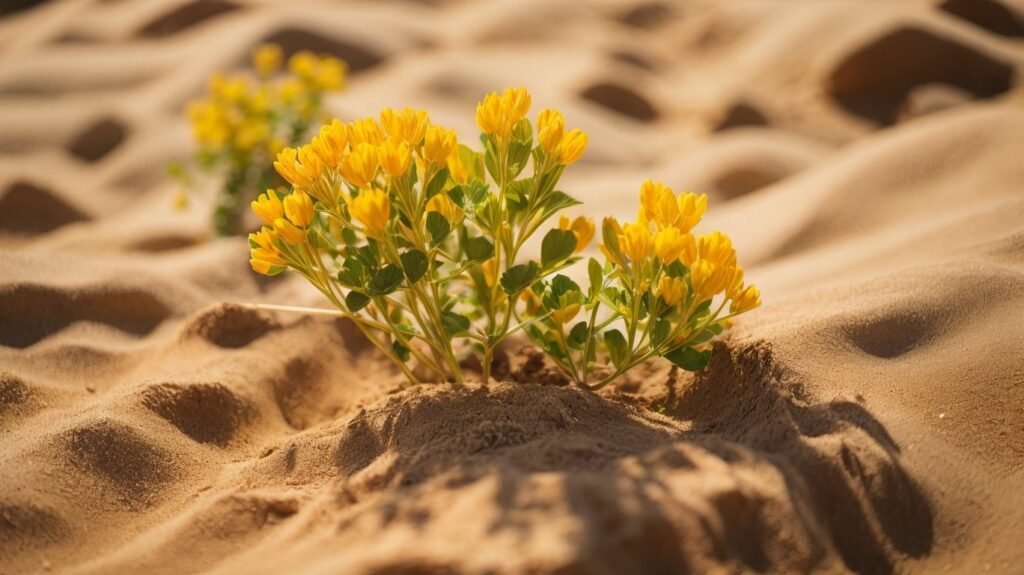Sandy soil is known for its loose, coarse texture and low nutrient content. This soil type has a high concentration of sand particles, making it difficult for plants to retain moisture and nutrients. However, with the right techniques and plant selection, sandy soil can be transformed into a fruitful and fertile environment.
One of the best plants to grow in sandy soil is clover. Clover is a type of legume known for its ability to fix nitrogen in the soil, making it an excellent choice for improving the quality of sandy soil. Furthermore, it is a hardy plant that can thrive in harsh conditions, making it suitable for sandy soil. In this article, we will discuss the best types of clover to grow in sandy soil and how to plant and maintain it properly.
One of the best types of clover to grow in sandy soil is white clover. This perennial plant has a shallow root system that can adapt well to sandy soil. It also can spread and cover the topsoil, reducing erosion and improving soil structure. Another suitable option is red clover, known for its deep root system that can penetrate the sandy soil and reach nutrients deeper in the ground. Alsike clover is another good choice as it has a high tolerance for drought and can thrive in sandy soil. Crimson clover and berseem clover are also suitable options as they can fix nitrogen in the soil and improve its quality.
To plant clover in sandy soil, follow these steps:
- Prepare the soil by removing debris and tilling it 4-6 inches. This will help loosen the soil and improve drainage.
- Choose the right time to plant, typically in late summer to early fall.
- Sow the seeds by evenly spreading them on the prepared soil. Lightly rake the seeds to cover them with a thin layer of soil.
- Water the area lightly to help the seeds germinate and establish in the soil. Fertilizing is unnecessary, as clover can fix its nitrogen from the air.
The benefits of growing clover in sandy soil include improving soil quality, fixing nitrogen, attracting pollinators, and providing forage for livestock. Additionally, clover can help suppress weeds and reduce erosion, making it a valuable plant for any garden or farm.
To maintain clover in sandy soil, follow these tips:
- Regularly mow the clover to a height of 3-4 inches. This will help promote growth and prevent the plant from becoming overgrown.
- Control weeds by hand-pulling or using an organic herbicide. Clover is a natural weed suppressor, but weeds can compete for nutrients and water.
- Rotate crops by planting different types of clover or other cover crops in the same area to improve soil quality and prevent nutrient depletion.
- Replant every few years to maintain a healthy and productive clover patch.
In conclusion, growing clover in sandy soil is not only beneficial for the plant itself but also for the overall health of the soil. With proper planting and maintenance, clover can thrive in sandy soil and improve its quality, making it a valuable addition to any garden or farm.
Key Takeaways:
- White, red, alsike, crimson, and berseem clover are the best types for sandy soil due to their ability to thrive in low-nutrient environments.
- Planting clover in sandy soil can improve soil quality, fix nitrogen, attract pollinators, and provide forage for livestock.
- To maintain clover in sandy soil, regularly mow, control weeds, rotate crops, and replant every few years to ensure optimal growth and benefits.
What Is Sandy Soil?
Sandy soil is a type of soil that is primarily composed of sand particles, giving it a gritty texture and good drainage. It is typically found in coastal or arid regions due to its low water-holding capacity. When selecting the best type of clover for sandy soil, it is important to consider the specific characteristics of this type of soil. Some clover varieties that thrive in sandy soil include:
- white clover
- red clover
- subterranean clover
as they have adaptations that allow them to tolerate the well-draining nature of this soil and effectively fix nitrogen in it.
Why Is Clover Good For Sandy Soil?
Clover is highly beneficial for sandy soil due to its natural ability to enhance soil structure, fertility, and water retention. The extensive clover root system plays a crucial role in preventing erosion by keeping the soil intact. Moreover, it enriches the soil with organic matter, boosting its fertility. The nitrogen-fixing properties of clover also contribute to increasing soil nitrogen levels, ultimately promoting plant growth. Additionally, the dense foliage of clover acts as a natural mulch, reducing water evaporation and improving water retention in sandy soil. Overall, incorporating clover into your garden or lawn can greatly enhance the health and productivity of sandy soil.
What Are The Best Types Of Clover For Sandy Soil?
When it comes to finding the perfect clover for sandy soil, it’s important to consider the specific needs and characteristics of the soil type. In this section, we will discuss the best types of clover that thrive in sandy soil conditions. From the traditional white and red clover to lesser-known varieties like alsike, crimson, and berseem clover, we will explore each type’s unique qualities and benefits. By the end, you’ll better understand which clover is best suited for your sandy soil.
1. White Clover
White clover is a highly beneficial plant for sandy soil, as it can improve soil quality, fix nitrogen, attract pollinators, and provide forage for livestock.
To successfully plant white clover in sandy soil, follow these steps:
- Prepare the soil by removing any weeds or rocks.
- Choose the right time to plant, typically in early spring or fall.
- Sow the seeds evenly, either by broadcasting or using a seed spreader.
- Water the area thoroughly and keep the soil moist during germination.
White clover has a rich history dating back to ancient Egypt, where it was used as a medicinal herb and a symbol of good luck. Its ability to thrive in sandy soil makes it valuable for ecological restoration and sustainable landscaping practices.
2. Red Clover
Red clover is a beneficial plant for sandy soil due to its ability to improve soil quality, fix nitrogen, attract pollinators, and provide forage for livestock. To successfully grow red clover in sandy soil, follow these steps:
- Prepare the soil by removing weeds or debris and loosening it with a garden fork or tiller.
- Choose the right time to plant, typically in early spring or late summer when the conditions are optimal for red clover growth.
- Sow the red clover seeds evenly across the soil, ensuring good seed-to-soil contact.
- Water the soil immediately after planting and keep it moist throughout germination.
Following these steps, you can cultivate red clover in sandy soil and enjoy its many benefits.
3. Alsike Clover
Alsike clover is an excellent option for sandy soil because it can thrive in poor soil conditions and withstand drought. To successfully plant and maintain alsike clover in sandy soil, follow these steps:
- Prepare the soil: Remove any weeds or debris and loosen the top layer of soil.
- Choose the right time to plant: Plant alsike clover in early spring or late summer when soil temperatures are cooler.
- Sow the seeds evenly over the soil and lightly rake them in.
- Water and fertilize: Keep the soil moist during germination and apply a balanced fertilizer according to package instructions.
The introduction of alsike clover proved to be a game-changer for a farmer in a sandy soil region. The clover improved soil quality, attracted pollinators, and provided nutritious forage for livestock. This resulted in increased crop yields and a thriving farm.
4. Crimson Clover
Crimson clover is a beneficial plant for sandy soil due to its ability to improve soil quality and fix nitrogen. To successfully plant this plant in sandy soil, follow these steps:
- Prepare the soil by removing any weeds or debris.
- Choose the right time to plant, typically in late summer or early fall.
- Sow the seeds evenly across the soil using a broadcast spreader or hand.
- Water the seeds immediately and continue to water regularly until they germinate.
Maintaining crimson clover in sandy soil requires:
- Regularly mowing the plants to promote healthy growth.
- Controlling weeds to prevent competition for nutrients and space.
- Rotating crops to prevent soil exhaustion.
- Replanting every few years to ensure a continuous supply of crimson clover.
5. Berseem Clover
Berseem clover is an excellent option for sandy soil as it can withstand drought and poor soil conditions. Here are the steps to successfully plant and maintain berseem clover in sandy soil:
- Prepare the soil by removing any weeds or debris.
- Choose the best time to plant, ideally in early spring or fall.
- Sow the berseem clover seeds evenly, covering them with a thin layer of soil.
- Water the soil regularly, especially during dry periods, to ensure proper moisture for seed germination.
Berseem clover offers numerous benefits in sandy soil, including improving soil quality, fixing nitrogen, attracting pollinators, and providing forage for livestock. To maintain berseem clover, it is important to mow to control weed growth regularly, rotate crops to prevent disease, and replant every few years to maintain optimal productivity.
How To Plant Clover In Sandy Soil?
Sandy soil can be challenging for many plants to thrive in, but with the right knowledge and techniques, clover can be successfully grown in this type of soil. In this section, we will discuss the steps to planting clover in sandy soil. From preparing the soil to choosing the right time to plant, sowing the seeds, and caring for the growing plants, we will cover all the necessary information to help you grow clover in sandy soil.
1. Prepare The Soil
Preparing the soil is crucial in successfully planting clover in sandy soil. Follow these steps to ensure the best conditions for growth:
- Remove any existing vegetation or weeds from the designated area.
- Loosen the soil by tilling or using a garden fork.
- Add organic matter, such as compost or well-rotted manure, to enhance soil structure.
- Test the pH of the soil using a testing kit and adjust, if necessary, to the optimal range for clover growth.
- Level the soil surface and remove any large clumps or debris.
Properly preparing the soil creates a favorable environment for clover to thrive, resulting in healthier plants and better overall results. Remember to monitor the soil moisture levels regularly and provide adequate water during dry periods for optimal growth.
2. Choose The Right Time To Plant
Choosing the perfect time to plant clover in sandy soil is crucial for its growth. Here are the steps to follow:
- Observe soil temperature: Wait until the soil temperature reaches around 50°F (10°C) for optimal germination.
- Consider the season: Spring and early fall are the best times to plant clover in sandy soil.
- Check rainfall: Ensure enough rainfall or irrigation is available to support seed germination and establishment.
- Assess frost risk: Avoid planting clover too late in the fall when frost could damage young plants.
By following these steps and choosing the right time to plant clover in sandy soil, you can increase its chances of successful establishment and growth.
3. Sow The Seeds
To successfully sow clover seeds in sandy soil, follow these steps:
- Prepare the soil by removing debris or weeds and loosening it with a garden fork or tiller.
- Choose the right time to plant, typically during early spring or fall when soil temperatures are cooler.
- Sow the seeds by broadcasting them evenly over the soil surface or using a seed spreader.
- Water the soil immediately after sowing to ensure good seed-to-soil contact and germination.
By following these steps, you can establish a healthy clover crop in sandy soil and enjoy its benefits, such as improving soil quality, fixing nitrogen, attracting pollinators, and providing forage for livestock. Remember to maintain the clover regularly by mowing it, controlling weeds, and considering crop rotation and replanting every few years.
4. Water And Fertilize
To properly water and fertilize clover in sandy soil, follow these steps:
- Watering: Provide consistent moisture to the soil, keeping it evenly moist but not waterlogged.
- Fertilizing: Apply a balanced fertilizer, such as a 10-10-10 blend, according to the recommended application rate.
- Timing: Water and fertilize immediately after planting and continue throughout the growing season.
- Amount: Apply enough water and fertilizer to nourish and hydrate the soil.
By following these steps, you can ensure that your clover in sandy soil receives the necessary water and nutrients for healthy growth.
What Are The Benefits Of Growing Clover In Sandy Soil?
Sandy soil can present challenges for gardeners and farmers alike, but growing clover in this soil type can bring numerous benefits. This section will explore the advantages of incorporating clover into sandy soil. From improving soil quality to providing forage for livestock, each sub-section will highlight a different benefit of growing clover in sandy soil. Get ready to discover the potential of this often-overlooked combination.
1. Improves Soil Quality
Improving the quality of sandy soil is essential for successful crop growth. Follow these steps to achieve this goal:
- Amend the soil: Adding organic matter such as compost or well-rotted manure can enhance water retention and nutrient content.
- Use cover crops: Planting clover or other nitrogen-fixing cover crops can increase soil fertility and prevent erosion.
- Practice crop rotation: Rotating crops annually can prevent nutrient depletion and reduce pest and disease pressure.
- Apply mulch: Mulching with organic materials can help retain moisture, regulate soil temperature, and improve soil health.
By following these steps and properly managing watering and fertility, the quality of sandy soil can gradually improve, making it more suitable for plant growth.
2. Fixes Nitrogen
Fixing nitrogen is one of the key benefits of growing clover in sandy soil. It is a natural process where certain types of clover plants can convert nitrogen from the air into a usable form for plants. This helps to enrich the soil and improve fertility. Here are the steps to take to leverage this nitrogen-fixing property in sandy soil:
- Choose the right type of clover, such as white or red, known for its ability to fix nitrogen.
- Prepare the soil by removing weeds and loosening it with a garden fork or tiller.
- Sow the clover seeds evenly across the sandy soil and lightly rake them in.
- Water the soil regularly, keeping it moist but not waterlogged.
By following these steps, you can successfully cultivate clover in sandy soil and benefit from its ability to fix nitrogen, ultimately improving soil fertility and promoting healthier plant growth.
3. Attracts Pollinators
Attracting pollinators is a key benefit of growing clover in sandy soil.
- Plant various clover species, such as white, red, alsike, crimson, and berseem clover, to attract diverse pollinators.
- Provide a suitable pollinator habitat by planting clover in sunny areas with minimal pesticide use.
- Ensure a continuous blooming period by planting different clover species that flower at different times.
- Encourage pollinators by providing a water source, such as a shallow dish with pebbles for them to land on.
Fun Fact: Bees are the most common pollinators attracted to clover due to their ability to extract nectar and pollen from its flowers.
4. Provides Forage For Livestock
Growing clover in sandy soil provides a valuable source of forage for livestock. Here are some steps to successfully utilize clover as livestock feed:
- Choose the right type of clover, such as white or red, that thrives in sandy soil and provides forage for livestock.
- Prepare the soil by removing any weeds or grass and ensuring proper drainage.
- Sow the clover seeds at the recommended depth and spacing.
- Water the soil regularly and provide necessary fertilization to promote healthy growth and provide forage for livestock.
Growing clover in sandy soil provides livestock with a nutritious food source and helps improve soil quality and attract pollinators.
How To Maintain Clover In Sandy Soil?
Sandy soil can be challenging for growing clover, but with proper maintenance, it can thrive and provide numerous benefits to your lawn or garden. This section will discuss the best ways to maintain clover in sandy soil. From regular mowing to crop rotation, we will cover the techniques to keep your clover healthy and flourishing. You can enjoy lush and vibrant clover growth in sandy soil following simple steps.
1. Regularly Mow
Regularly mowing clover in sandy soil is essential for proper growth and maintenance. Here are the steps to follow:
- Establish a regular mowing schedule to keep the clover at an optimal height.
- Use a sharp mower blade to prevent damage to the plants.
- Mow when the clover reaches a height of around 4-6 inches to encourage lateral growth.
- Set the mower to 2-3 inches in height to avoid cutting the clover too short.
- Collect the clippings after mowing to prevent them from smothering the clover.
Regularly mowing the clover helps to control weeds, stimulates growth, and promotes a healthy stand of clover in sandy soil.
2. Control Weeds
To effectively control weeds in sandy soil when growing clover, follow these steps:
- Regularly inspect the clover area for weed growth.
- Use methods to control weeds, such as manual removal or mulch to suppress germination and growth.
- Consider using organic weed control methods, such as vinegar-based herbicides or boiling water.
- By implementing these weed control measures, you can ensure that your clover thrives in sandy soil, promoting its beneficial properties and providing a healthy environment for other plants to grow.
Controlling weeds in sandy soil is important because they compete with clover for nutrients and resources, potentially compromising its growth and productivity. By following these steps, you can effectively manage and prevent weed growth in your clover area. This will help promote the beneficial properties of clover and create a healthy environment for other plants to thrive.
3. Rotate Crops
Rotating crops in sandy soil is essential to maintain soil health and prevent nutrient depletion. Here are the steps to successfully rotate crops in sandy soil:
- Choose a crop rotation plan that includes nitrogen-fixing plants like clover.
- After harvesting the previous crop, remove any plant debris to prevent the spread of diseases.
- Amend the soil with organic matter like compost or well-rotted manure to improve its fertility.
- Select a different crop that has different nutrient requirements from the previous one.
- Plant the new crop according to its specific planting guidelines, spacing, and depth.
Pro-tip: To maximize the benefits of crop rotation, consider incorporating cover crops like clover during fallow periods to improve soil structure and increase nutrient availability.
4. Replant Every Few Years
To maintain the health and productivity of clover in sandy soil, it is important to replant every few years. Here are the steps to follow when replanting clover in sandy soil:
- Assess the condition of the soil and determine if replanting is necessary.
- Prepare the soil by removing weeds and debris and loosening it with a garden fork or tiller.
- Choose the right time to replant, usually in early spring or fall when the soil is moist and temperatures are mild.
- Sow the clover seeds evenly across the prepared soil, following the recommended planting depth and spacing.
- Water the newly planted clover seeds thoroughly and moisten the soil during germination.
- Fertilize the soil with a balanced fertilizer to provide essential nutrients for growth.
- Monitor the growth of the clover and ensure it has adequate sunlight and water.
- Control weeds by regular mowing or hand-pulling to prevent competition with the clover.
- Rotate crops every few years to prevent soil depletion and disease buildup.
- Replant clover periodically to maintain its vigor and productivity in sandy soil.
Frequently Asked Questions
What type of clover is best for sandy soil?
Ladino clover is recommended for sandy soil, as it performs well in this type of soil.
Is ladino clover suitable for sandy soil?
Yes, ladino clover is suitable for sandy soil. It is a good option for those looking to plant clover in sandy soil.
What is the recommended planting method for clover in sandy soil?
The “throw n mow” method is often recommended for planting clover in sandy soil. This involves scattering the seeds and then mowing over them.
Why is minimizing tilling important when planting clover in sandy soil?
Minimizing tilling is important because it helps to preserve the existing root system. This is beneficial for the overall health and growth of the clover.
Are you willing to use extra seed to minimize tilling in sandy soil?
Yes, even if it requires more seed, avoiding disrupting the existing root system is worth it. The goal is to minimize tilling and preserve the root system.
Is ladino clover ideal for sandy soil?
Yes, ladino clover is ideal for sandy soil. It has been proven to thrive in this soil type, making it a great choice for planting in sandy areas.



